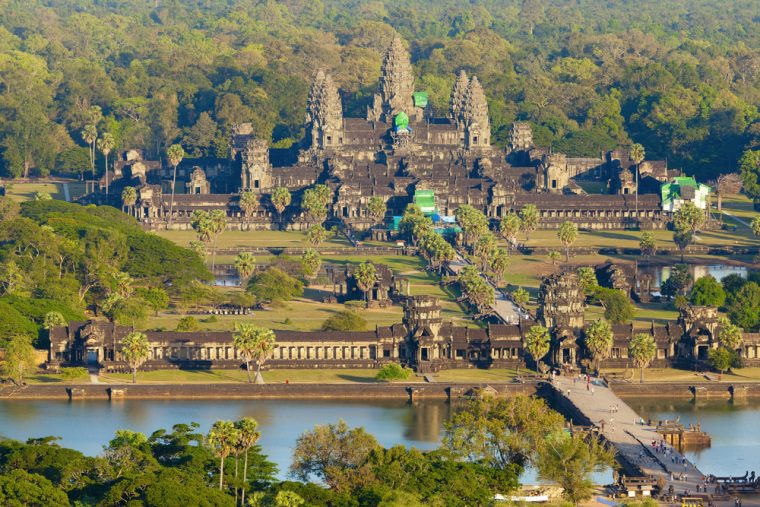Angkor Wat is a very mystical and mysterious temple hidden deep in the forests 5.5 km north of Siem Reap, Cambodia. The elegant towers stretching into the sky at Angkor Archaeological Park are described as “the most magnificent and harmonious work that the human brain has ever designed.”
Angkor Wat, which includes more than fifty temples, was built in approximately 30 years during the Khmer Kingdom, which ruled for 630 years. While it is compared with Ancient Greek and Roman architecture in terms of the compatibility in its design, it is mentioned in the same category with the Pyramids, Machu Picchu and Taj Mahal in terms of architecture and art. The temple has been on the UNESCO World Heritage List since 1992.
Angkor Wat is actually a city full of religious artifacts of the Khmer Empire. In Khmer language, ‘Angkor’ means city and ‘Wat’ means temple. When we say ‘Angkor’, think of an area of 1000 square kilometers with nearly a hundred temples, tombs or ancient ruins. When we say ‘Angkor Wat’, it is necessary to understand one of the most important temples of this old city.
Angkor Wat and the legend of Cambodia
According to legend, Cambodia; The ruler of the seas consists of the daughter of the great dragon Naga and the Brahmin Indian youth, Kaudinya. One day, while sailing on his boat, Kaudinya sees the princess and falls in love. The princess’s father, Naga, who is the ruler of the seas, gives his daughter all the waters of the region under his rule as a marriage gift and gives this land to them, and the Kingdom of Kambuja is thus established.
Angkor Wat was built in the 12th century by the Khmer King Suryavarman II (1113-1150), who ruled a magnificent wealth, in the name of the Hindu gods Shiva, Vishnu and Brahma. The striking structure, which is also embroidered on Cambodia’s national flag, was converted from a Hindu temple to a Buddhist temple in the 13th century.
Angkor Wat Temples were spread over an area of 82 hectares, inhabited by more than 1 million people in the 12th century. Angkor Ancient City bears the traces of the hewn stonework and building art of the Khmer people, who established a wide water distribution network with their proper urban planning plans.
Angkor Wat, the capital of the mighty Khmer Kingdom and the symbol of its power, is one of the most striking engineering projects ever realized, not only in terms of size but also in terms of being built on water.
A huge water-filled moat surrounds Angkor Wat, large enough to be seen from space, surrounding the ancient structure. The moats represent the seas surrounding Mount Meru, the home of the Hindu gods. West Baray, the largest of the artificial water channels, is 8 kilometers long and 2.4 kilometers wide.
The river and rainwater collected with incredible engineering skills was used to quench the thirst of the largest industrial city of the time, with a population approaching 1 million. In addition, this system was also used to water the rice, which was used as money in Khmer.
It is unknown why the rulers of Angkor left and settled in modern Phnom Penh. Theories are that in the 13th century, pressure and attacks from the neighboring Kingdom of Siam increased and the kingdom could not stand it any longer and moved from Angkor to the current capital Phnom Penh. However, this mystery has plagued scientists for centuries.
According to some scholars, the collapse of the city’s elaborate water system may have brought about the end of Angkor. A few weak monsoons and natural causes such as canals clogged by increased flooding due to deforestation are thought to be the reason for heading to Phnom Penh.



Abandoned for four centuries and surrounded by forest, these ancient temples were rediscovered in 1858 by the French naturalist Henri Mouhot. Although the temples are known by the Khmer natives and the westerners who visit this region from time to time, the whole world hears the existence of Angkor when Mouhot’s book is published. The scientist who mentioned Angkor in his book saying, “You cannot die without being seen”, died a year after his discovery.
Located in the heart of the jungles of Cambodia, the lands and wild grasses gathered on the temple were cleared in the 20th century. Although the maintenance works stopped during the Khmer Rouge period between 1970-80, restoration works started again after it was included in the UNESCO List after the 90s.
When it was added to the list of World Heritage sites, it was also added to the list of endangered heritage sites. This magnificent site has been put in great danger by illegal excavations and even being laid by mines. In 1993, UNESCO launched a massive mobilization to protect and restore Angkor.
Finally, with fruitful efforts, it was removed from the list of World Heritage in Danger in 2004. The German Apsara Conservation Project (GACP) has protected angel statues and wall sculptures. UNESCO still has an important place in Angkor’s future, working with Cambodian authorities to ensure that tourism and environmental development do not harm this region.
Even after its glory days have passed, Angkor has not lost its importance to Buddhists from Southeast Asia and beyond. Today, the region attracts about 1 million visitors a year from all backgrounds.
Angkor Wat is the most famous of the temples in Angkor. Along with Bayon, which is surrounded by smiling human faces, Preah Ko, Bakheng, Koh Ker, Banteay Srei, Klang, and Baphuon are among the interesting temples.
1. Angkor Wat
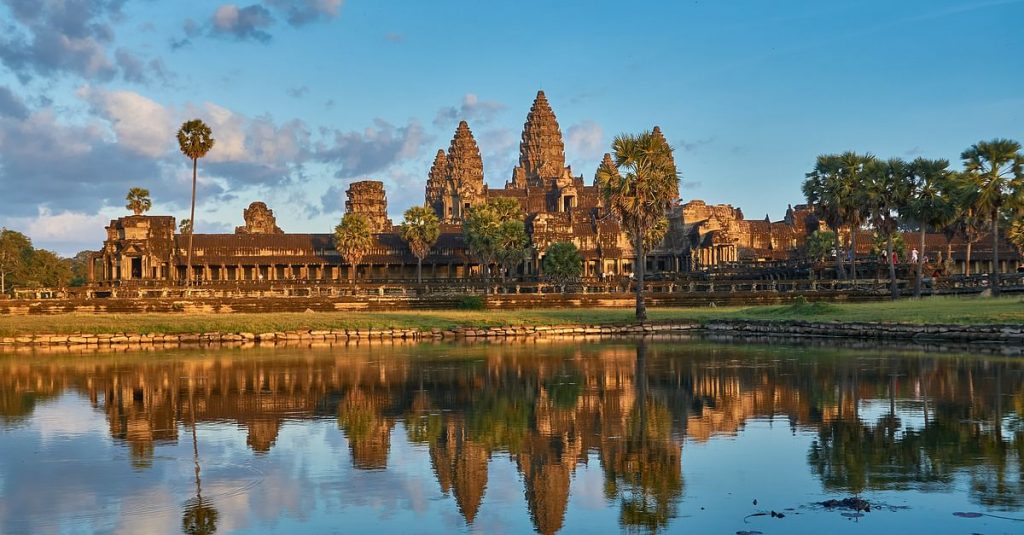


Angkor Wat is the most well-known of the more than fifty temples built during the 630-year Khmer Kingdom. When Angkor Wat was built, it was unlike any other medieval religious building in the world. Angkor Wat consists of five towers, each 55 meters high, in the shape of a lotus flower rising to the sky.
Much larger than any cathedral in Europe, Angkor Wat remains one of the largest temples in the world. More stones than the Egyptian Pyramids were used in the construction of this place, which is both the mausoleum of King Suryavarman II and a Hindu temple dedicated to the God Vishnu, and reliefs are carved on each stone.
Khmer architects used sandstone as the main building material. There are reliefs on the outer walls of the inner temple, totaling 800 meters. Everything in the structure is symmetrical, whatever is on the right is the same on the left. Unlike many other temples, this one faces west.
2. Angkor Thom
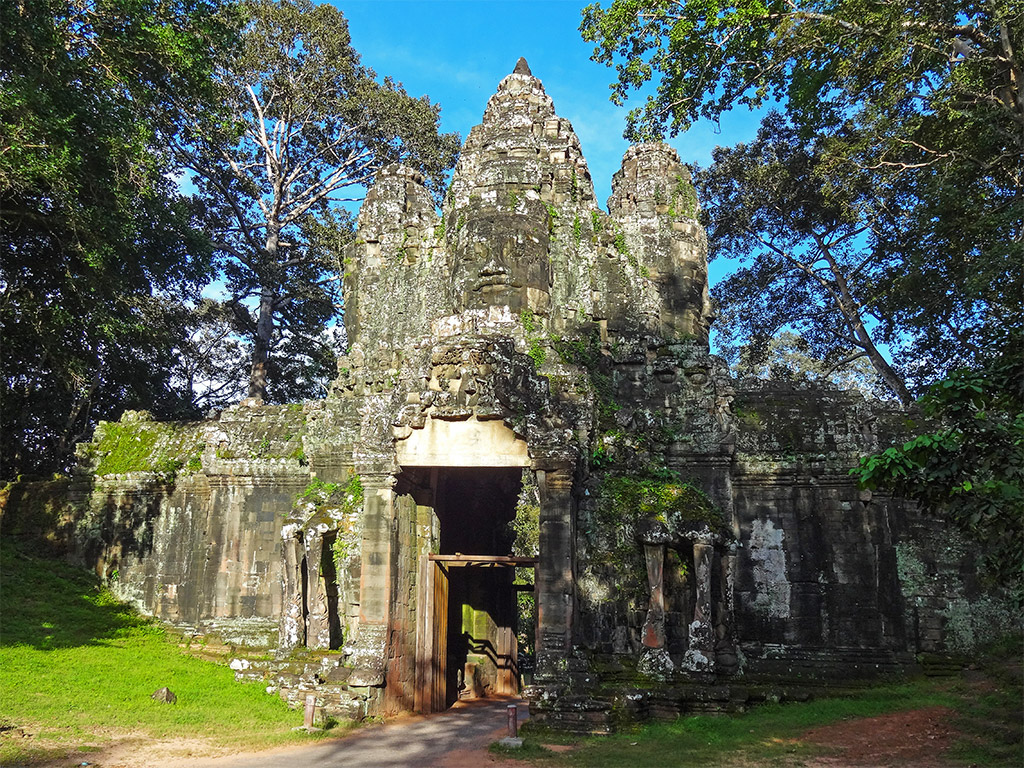


Angkor Thom is a 700-year-old temple built after Angkor Wat. It was the last capital of the Khmer Empire. The temple, which has doors decorated with relief images of good spirits and demons, is thought to have been built on the ancient capital Yasodharapura, which was destroyed by a war at that time.
The 54 towers located in Bayon, the main center of this temple, symbolize 54 regions from the ancient kingdom. In this temple, where there are more than 11 thousand reliefs on the walls, the length of some reliefs depicting the stories told reaches 120 meters. Built by King Jayavarman VII at the end of the 12th century, the temple is believed to have the power to see and control everything, with 216 smiling faces.
3. Ta Prohm
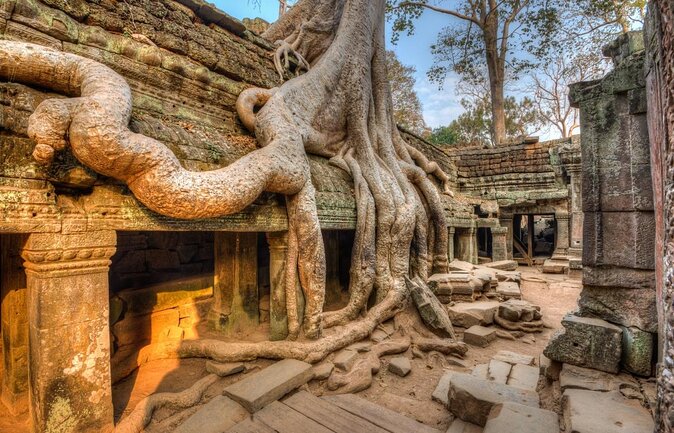


Ta Prohm is the most interesting temple in Angkor. When this temple was used as a movie set in Angelina Jolie’s Tomb Raider movies, it became one of the most well-known temples. It is thought that 10,000 people lived in this temple area, which King Jayavaman VII had his mother built in 1186.
When the temple was abandoned over time, nature was rapidly renewed and the huge Banyan trees growing on the temple almost swallowed the temple with their roots. The giant roots surrounding the temple reveal images that are unique in the world. Although many plants and trees were cleaned during the restoration works, it was not possible to clean these trees because their roots encircled the entire temple.
4. Baphuon Temple
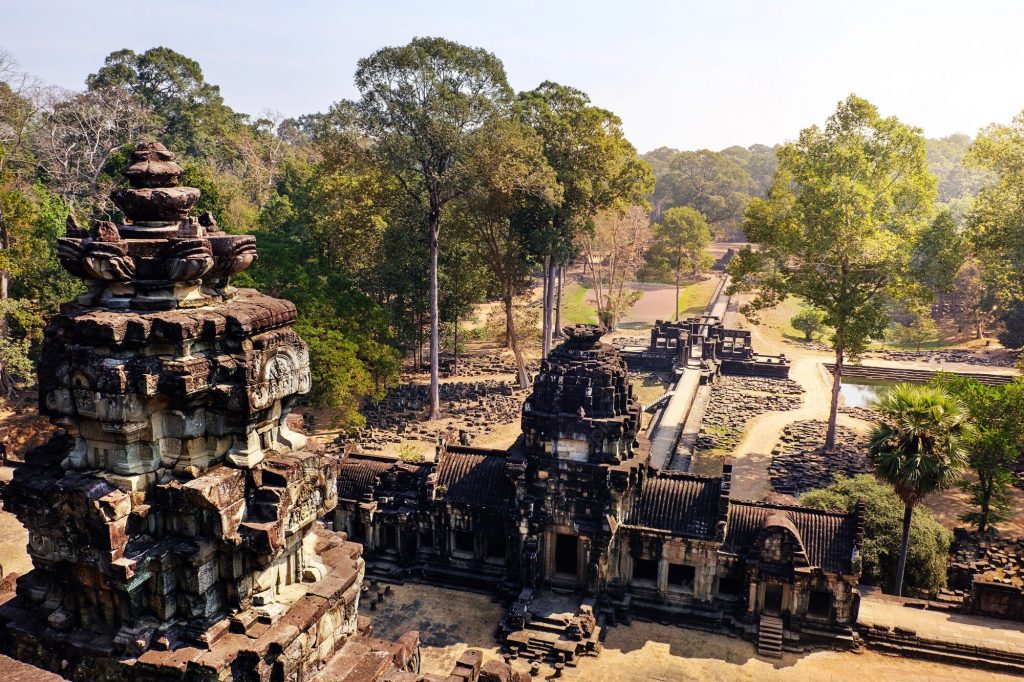


Baphuon Temple is the oldest of the Angkor temples. Dedicated to Lord Shiva by Udayadityarvarman II in the 11th century, this 3-story temple is the only surviving Hindu temple in this area. The thousand-year-old Baphoun, once the most magnificent temple in Angkor, was on the verge of collapse in the 1950s.
Thinking that the only way to save the monument was to disassemble the temple, French archaeologists dismantled and numbered the uniquely designed stones in the temple in the 1960s and spread them over the forest area. Restoration work was interrupted due to the civil war.
When the Khmer Rouge, which took power in 1975, destroyed the records necessary for the construction of the monument, the world’s largest and most difficult puzzle began. Restarting the restoration in 1995, the team continues to work on the world’s largest 3D puzzle, where mortar is not used and each stone has a special and separate place.
5. Banteay Srei
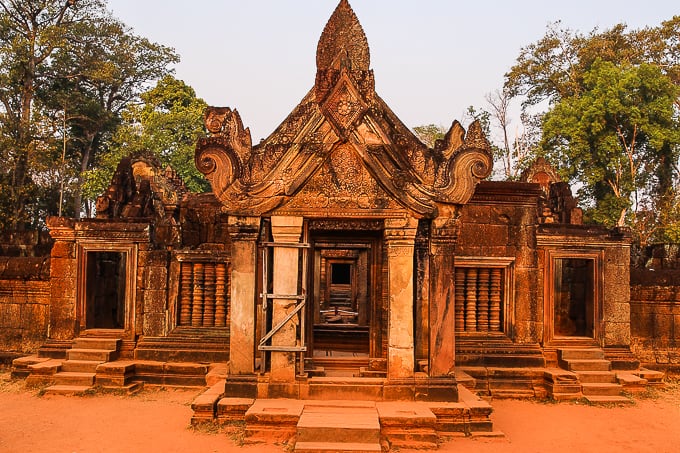


Banteay Srei is also known as the Temple of Women, built in the second part of the 10th century. It is obvious that the hand of women has touched the extraordinary stone reliefs made on the red sandstone used in this well-preserved temple. Banteay Srei Temple, considered the crown of classical Khmer art, is located approximately 40 km from Angkor Wat.
6. Phnom Bakheng
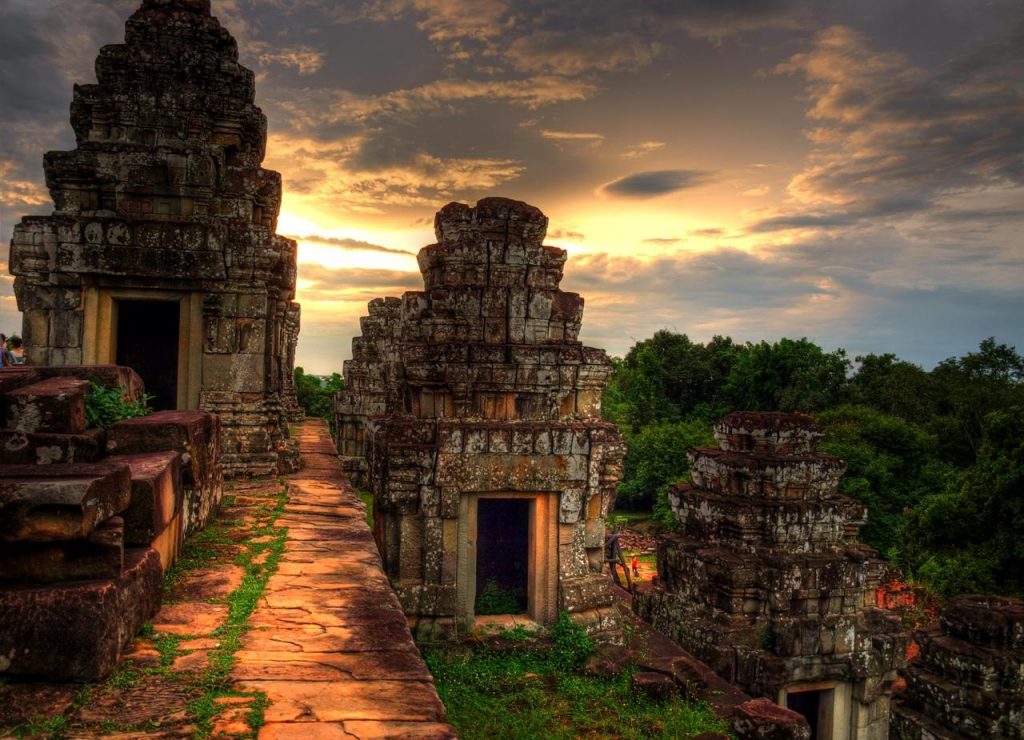


Phnom Bahheng, a temple built on the top of Bakheng in the early 10th century, can be walked on elephants if desired. Although Phnom Bakheng Temple is not as magnificent as other Angkor temples, it is one of the most beautiful places to watch the sunset because it was built on a hill.
